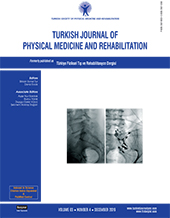Does kinesiotaping affect standing balance in healthy individuals? A pilot, double-blind, randomized-controlled study
2 Department of Physical Medicine and Rehabilitation, University of Health Sciences, Ankara Gaziler Physical Medicine and Rehabilitation Training and Research Hospital, Ankara, Turkey
3 Department of Biostatistics, Van Yüzüncü Yıl University Faculty of Medicine, Van, Turkey DOI : 10.5606/tftrd.2019.3788 Objectives: This study aims to investigate the immediate and short-term effects of kinesiotaping (KT) on balance, when applied to the ankles of healthy individuals.
Patients and methods: In this pilot, double-blind, randomized, sham-controlled study, a total of 24 healthy male individuals (mean age 31.8 years; range, 22 to 40 years) were randomized into two groups as KT and sham between January 2014 to March 2014. The KT group had a therapeutic KT application which could provide the ankle stability. The control group had a prespecified sham application. Balance testing was done before, immediately after and 24 hours after the application of KT. Anteroposterior, mediolateral, and overall stability indexes (APSI, MLSI, and OSI, respectively) were measured and given in relative treatment effect (RTE).
Results: There was no statistically significant interaction between the intervention and time for all stability indexes. The main effects were evaluated. The main effect of time showed a significant difference in terms of RTE and mean ranks at all time points for the MLSI and OSI (p=0.034 and p=0.009, respectively). The KT of ankle had an immediate positive effect on standing balance of healthy individuals which did not sustain after 24 hours. The main effect of group showed that there was a significant difference in the RTE levels between the intervention groups for all indexes. Based on the rank means, the KT group had a better stability than the sham group for all indexes.
Conclusion: Our study results suggest that KT of ankle has an immediate positive effect on standing balance of healthy individuals by increasing mediolateral stability of the ankle.
Keywords : Balance, kinesiotaping, postural stability
















